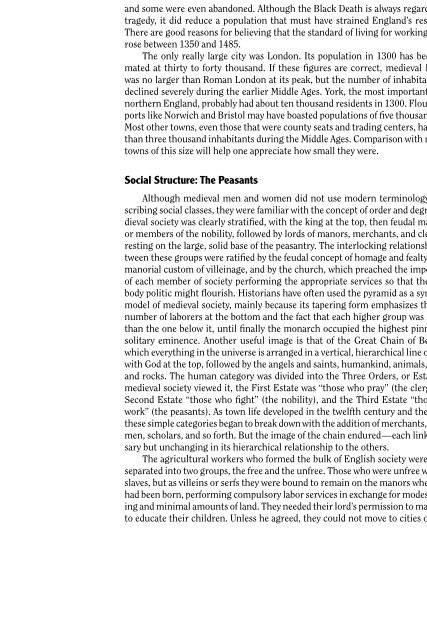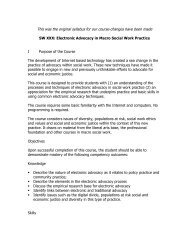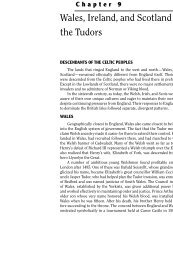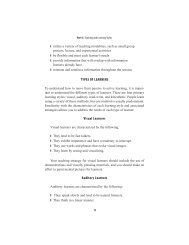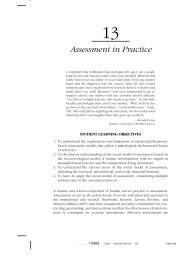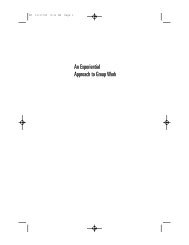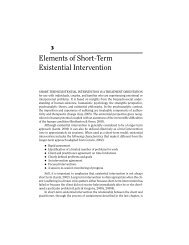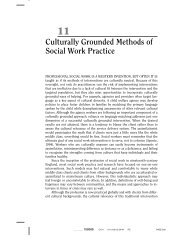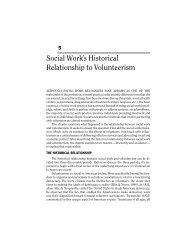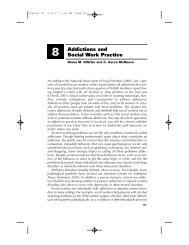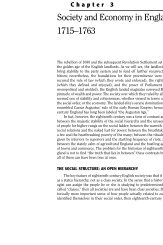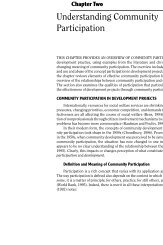Chapter 6 Medieval British Society, 1066–1485 - Lyceum Books
Chapter 6 Medieval British Society, 1066–1485 - Lyceum Books
Chapter 6 Medieval British Society, 1066–1485 - Lyceum Books
You also want an ePaper? Increase the reach of your titles
YUMPU automatically turns print PDFs into web optimized ePapers that Google loves.
116 Part II Norman Britain<br />
and some were even abandoned. Although the Black Death is always regarded as a<br />
tragedy, it did reduce a population that must have strained England’s resources.<br />
There are good reasons for believing that the standard of living for working people<br />
rose between 1350 and 1485.<br />
The only really large city was London. Its population in 1300 has been estimated<br />
at thirty to forty thousand. If these fi gures are correct, medieval London<br />
was no larger than Roman London at its peak, but the number of inhabitants had<br />
declined severely during the earlier Middle Ages. York, the most important city in<br />
northern England, probably had about ten thousand residents in 1300. Flourishing<br />
ports like Norwich and Bristol may have boasted populations of fi ve thousand each.<br />
Most other towns, even those that were county seats and trading centers, had fewer<br />
than three thousand inhabitants during the Middle Ages. Comparison with modern<br />
towns of this size will help one appreciate how small they were.<br />
Social Structure: The Peasants<br />
Although medieval men and women did not use modern terminology in describing<br />
social classes, they were familiar with the concept of order and degree. <strong>Medieval</strong><br />
society was clearly stratifi ed, with the king at the top, then feudal magnates<br />
or members of the nobility, followed by lords of manors, merchants, and clergy, all<br />
resting on the large, solid base of the peasantry. The interlocking relationships between<br />
these groups were ratifi ed by the feudal concept of homage and fealty, by the<br />
manorial custom of villeinage, and by the church, which preached the importance<br />
of each member of society performing the appropriate services so that the whole<br />
body politic might fl ourish. Historians have often used the pyramid as a symbol or<br />
model of medieval society, mainly because its tapering form emphasizes the large<br />
number of laborers at the bottom and the fact that each higher group was smaller<br />
than the one below it, until fi nally the monarch occupied the highest pinnacle in<br />
solitary eminence. Another useful image is that of the Great Chain of Being, in<br />
which everything in the universe is arranged in a vertical, hierarchical line or chain<br />
with God at the top, followed by the angels and saints, humankind, animals, plants,<br />
and rocks. The human category was divided into the Three Orders, or Estates. As<br />
medieval society viewed it, the First Estate was “those who pray” (the clergy), the<br />
Second Estate “those who fi ght” (the nobility), and the Third Estate “those who<br />
work” (the peasants). As town life developed in the twelfth century and thereafter,<br />
these simple categories began to break down with the addition of merchants, guildsmen,<br />
scholars, and so forth. But the image of the chain endured—each link necessary<br />
but unchanging in its hierarchical relationship to the others.<br />
The agricultural workers who formed the bulk of English society were legally<br />
separated into two groups, the free and the unfree. Those who were unfree were not<br />
slaves, but as villeins or serfs they were bound to remain on the manors where they<br />
had been born, performing compulsory labor services in exchange for modest housing<br />
and minimal amounts of land. They needed their lord’s permission to marry and<br />
to educate their children. Unless he agreed, they could not move to cities or other


